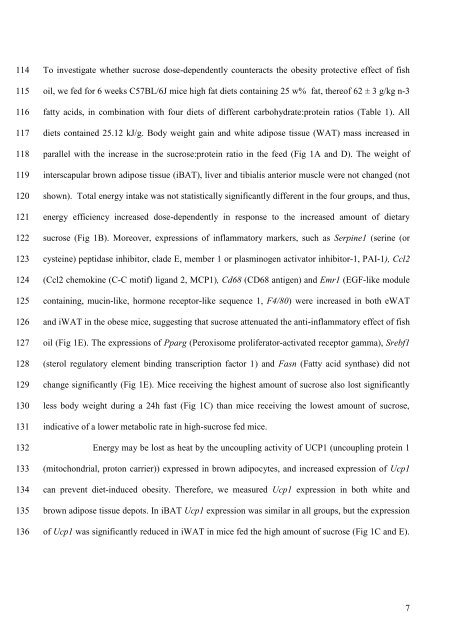The obesogenic effects of polyunsaturated fatty acids are dependent ...
The obesogenic effects of polyunsaturated fatty acids are dependent ...
The obesogenic effects of polyunsaturated fatty acids are dependent ...
Create successful ePaper yourself
Turn your PDF publications into a flip-book with our unique Google optimized e-Paper software.
114<br />
115<br />
116<br />
117<br />
118<br />
119<br />
120<br />
121<br />
122<br />
123<br />
124<br />
125<br />
126<br />
127<br />
128<br />
129<br />
130<br />
131<br />
132<br />
133<br />
134<br />
135<br />
136<br />
To investigate whether sucrose dose-<strong>dependent</strong>ly counteracts the obesity protective effect <strong>of</strong> fish<br />
oil, we fed for 6 weeks C57BL/6J mice high fat diets containing 25 w% fat, there<strong>of</strong> 62 ± 3 g/kg n-3<br />
<strong>fatty</strong> <strong>acids</strong>, in combination with four diets <strong>of</strong> different carbohydrate:protein ratios (Table 1). All<br />
diets contained 25.12 kJ/g. Body weight gain and white adipose tissue (WAT) mass increased in<br />
parallel with the increase in the sucrose:protein ratio in the feed (Fig 1A and D). <strong>The</strong> weight <strong>of</strong><br />
interscapular brown adipose tissue (iBAT), liver and tibialis anterior muscle were not changed (not<br />
shown). Total energy intake was not statistically significantly different in the four groups, and thus,<br />
energy efficiency increased dose-<strong>dependent</strong>ly in response to the increased amount <strong>of</strong> dietary<br />
sucrose (Fig 1B). Moreover, expressions <strong>of</strong> inflammatory markers, such as Serpine1 (serine (or<br />
cysteine) peptidase inhibitor, clade E, member 1 or plasminogen activator inhibitor-1, PAI-1), Ccl2<br />
(Ccl2 chemokine (C-C motif) ligand 2, MCP1), Cd68 (CD68 antigen) and Emr1 (EGF-like module<br />
containing, mucin-like, hormone receptor-like sequence 1, F4/80) were increased in both eWAT<br />
and iWAT in the obese mice, suggesting that sucrose attenuated the anti-inflammatory effect <strong>of</strong> fish<br />
oil (Fig 1E). <strong>The</strong> expressions <strong>of</strong> Pparg (Peroxisome proliferator-activated receptor gamma), Srebf1<br />
(sterol regulatory element binding transcription factor 1) and Fasn (Fatty acid synthase) did not<br />
change significantly (Fig 1E). Mice receiving the highest amount <strong>of</strong> sucrose also lost significantly<br />
less body weight during a 24h fast (Fig 1C) than mice receiving the lowest amount <strong>of</strong> sucrose,<br />
indicative <strong>of</strong> a lower metabolic rate in high-sucrose fed mice.<br />
Energy may be lost as heat by the uncoupling activity <strong>of</strong> UCP1 (uncoupling protein 1<br />
(mitochondrial, proton carrier)) expressed in brown adipocytes, and increased expression <strong>of</strong> Ucp1<br />
can prevent diet-induced obesity. <strong>The</strong>refore, we measured Ucp1 expression in both white and<br />
brown adipose tissue depots. In iBAT Ucp1 expression was similar in all groups, but the expression<br />
<strong>of</strong> Ucp1 was significantly reduced in iWAT in mice fed the high amount <strong>of</strong> sucrose (Fig 1C and E).<br />
7
















